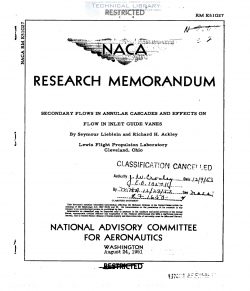naca-rm-e51g27
- Version
- 44 Downloads
- 2.84 MB File Size
- 1 File Count
- May 25, 2017 Create Date
- May 25, 2017 Last Updated
National Advisory Committee for Aeronautics, Research Memorandum - Secondary Flows in Annular Cascades and Effects of Flow in Inlet Guide Vanes

An analysis of the flow across an annular cascade of axial-flow
inlet guide vanes was conducted in order to evaluate the role of sec-
ondary flows in causing discrepancies between design and observed
velocity diagrams. A qualitative discussion of the general nature of
the secondary flows within the passages of stationary annular cas-
cades with radial design variations of circulation is presented for
both the end-wall boundary-layer regions and the central potential-
flow regions of the blade passage. Deviations from ideal mean outlet
flows (as determined on the basis of blade-element performance) were
shown to exist in the potential—flow region of the vanes because of
conditions imposed by the end-wall boundaries, the displacement of the
wall boundary—layer surfaces, and the irrotationality requirement. As
a consequence of the existence of nonuniform radial flows across the
blade spacing in the actual flow through cascades, it may not generally
be possible to obtain any arbitrarily specified design variation of
turning angle along the radial height of a blade row.
Quantitative evaluations of the variation of the actual mean flow
leaving a row of inlet guide vanes were obtained by the method of
singularities in which a distribution of vorticity directly proportional
to the ideal circulation variation of the design was superimposed on
the ideal blade-element flow. Induced turning-angle deflections were
calculated from the induced velocities of the superimposed vortex
system. With the use of an empirically determined correlation factor,
good agreement was obtained. between calculated and experimental radial
variations of turning angle for several conventional inlet guide vanes
for which accurate blade-element turning-angle design data were avail-
able.
The existence of secondary flows within the passages of blade
rows is recognized as having an important effect on the performance of
axial—flow compressors and turbines (references 1 and 2). The term
"secondary flow" is generally used to represent deviations of the
actual flow from distributions determined on the basis of the perform,
ance of individual blade elements. Secondary flows in a cascade of
blades arise primarily from the effects of blade twist and endrwall
boundary layers.
The effects of secondary flows on the performance of a series of
blade rows may be classified into two general types: The first effect
appears as a direct or inherent loss due to the absorption of energy
from the through flow in order to produce the secondary motions and
due to the partial dissipation of this energy by viscous action. The
second effect is an indirect or matching loss due to the deviations
from design values of the direction and magnitude of the velocities
leaving one blade row and entering the next.
| File | Action |
|---|---|
| naca-rm-e51g27 Secondary Flows in Annular Cascades and Effects of Flow in Inlet Guide Vanes.pdf | Download |

Comment On This Post